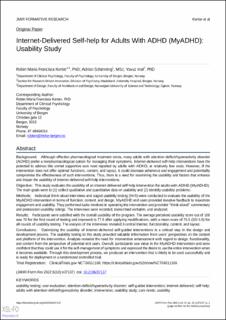| dc.description.abstract | Background:
Although effective pharmacological treatment exists, many adults with attention-deficit/hyperactivity disorder (ADHD) prefer a nonpharmacological option for managing their symptoms. Internet-delivered self-help interventions have the potential to address this unmet supportive care need reported by adults with ADHD, at relatively low costs. However, if the intervention does not offer optimal functions, content, and layout, it could decrease adherence and engagement and potentially compromise the effectiveness of such interventions. Thus, there is a need for examining the usability and factors that enhance and impair the usability of internet-delivered self-help interventions.
Objective:
This study evaluates the usability of an internet-delivered self-help intervention for adults with ADHD (MyADHD). The main goals were to (1) collect qualitative and quantitative data on usability and (2) identify usability problems.
Methods:
Individual think-aloud interviews and staged usability testing (N=5) were conducted to evaluate the usability of the MyADHD intervention in terms of function, content, and design. MyADHD end users provided iterative feedback to maximize engagement and usability. They performed tasks involved in operating the intervention and provided “think-aloud” commentary and postsession usability ratings. The interviews were recorded, transcribed verbatim, and analyzed.
Results:
Participants were satisfied with the overall usability of the program. The average perceived usability score out of 100 was 70 for the first round of testing and improved to 77.5 after applying modifications, with a mean score of 75.5 (SD 5.9) for all rounds of usability testing. The analysis of the interviews revealed 3 central themes: functionality, content, and layout.
Conclusions:
Optimizing the usability of internet-delivered self-guided interventions is a critical step in the design and development process. The usability testing in this study provided valuable information from users’ perspectives on the content and platform of the intervention. Analysis revealed the need for intervention enhancement with regard to design, functionality, and content from the perspective of potential end users. Overall, participants saw value in the MyADHD intervention and were confident that they could use it for the self-management of symptoms and expressed the desire to use the entire intervention when it becomes available. Through this development process, we produced an intervention that is likely to be used successfully and is ready for deployment in a randomized controlled trial. | en_US |

